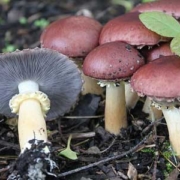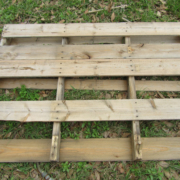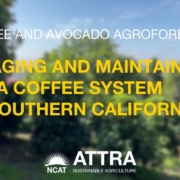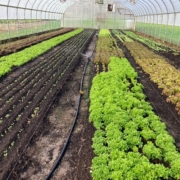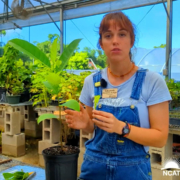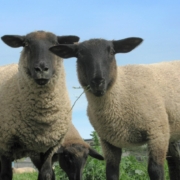Wine Cap Mushroom Production: Getting Started
 Print This Post
Print This Post
By Nina Prater, NCAT Sustainable Agriculture Specialist
Last year, the NCAT Southeast office partnered with the University of Missouri’s Agroforestry Center to host a one-day mushroom cultivation workshop in Fayetteville, Arkansas. Gregory Ormsby Mori with the Agroforestry Center provided hands-on instruction, showing multiple ways of growing mushrooms. These included shiitake mushrooms in logs, oyster mushrooms grown on log totems, and wine cap mushrooms grown in a straw/woodchip bed. (Read a re-cap of the event here). My husband Jeremy and I attended the workshop and were inspired to get started right away. We have a livestock farm in the Ozark Mountains of Arkansas, but we’re always looking for ways to diversify our operation. Mushrooms seemed like a good fit. We manage over 100 acres of forest, a ready source of both material and shady land for mushroom production.
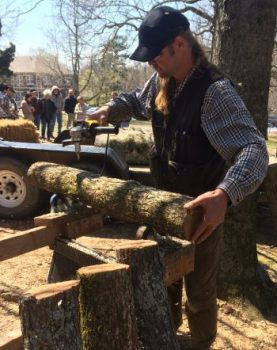
Jeremy Prater practicing his shiitake mushroom inoculation skills at the mushroom workshop in Fayetteville, AR. Photo: Nina Prater, NCAT
Making a Wine Cap Mushroom Bed
There’s nothing quite like a hands-on workshop to inspire you to dive right into a new project. After the workshop, we went home and ordered spawn for oyster mushrooms, shiitakes, and wine caps. We got the oyster mushroom totems and shiitake logs inoculated last spring, but ran out of time to do the wine caps. We stored the wine cap spawn in the back of the fridge for a year (farmers’ fridges are such interesting places—we also have animal vaccines and pawpaw seeds tucked in the back at the moment). In early April of this year, we were able to establish a wine cap mushroom bed.
You can watch this short video to see exactly how we made our wine cap mushroom bed. If you prefer a very brief written version, it’s easy: you find a shady spot either within your garden under tall plants, or in a wooded area. First, clear the surface to expose the soil and sprinkle some spawn. Next, start layering your wood chips (hardwood preferably), spawn, fresh straw, then spawn again. Continue that lasagna-like pattern (chips, spawn, straw, spawn) until you run out of spawn. Finally, top it off with wood chips to hold it all down. Soaking your wood chips and straw ahead of time is ideal.
In our video, you can see that we watered the materials as we went, since we were not able to pre-soak. We have followed up on this by making sure we watered the bed well on days it didn’t rain. It’s too early yet to say if we were successful, but I’m already optimistically researching wine cap mushroom recipes.
Related Resources
Mushrooms are a great way to add diversity to your farm operation. On our farm, we’re doing it primarily for our own consumption. But our secondary purpose is as a trial-run to see if it is something we would enjoy doing commercially. To learn more about mushroom cultivation, check out these resources:
ATTRA Publication:
Mushroom Cultivation and Marketing
ATTRA Podcast:
Introduction to Mycology
University of Missouri:
Cultivation and Cuisine: Getting Started with Wine Cap Mushrooms, By Hannah Hemmelgarn, University of Missouri Center for Agroforestry.

